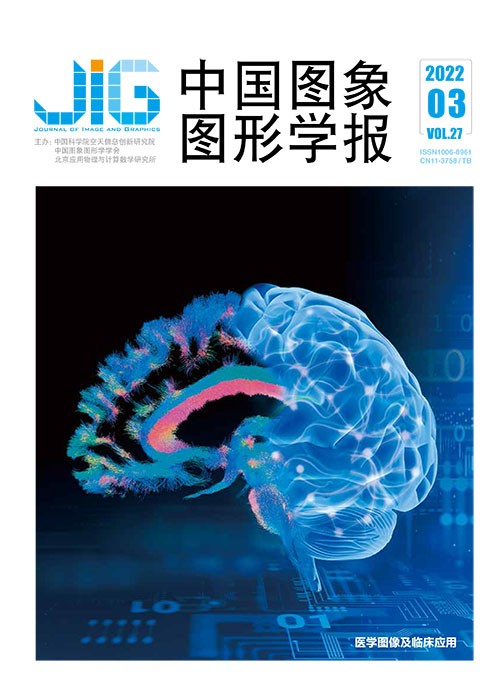
基于特征选择与残差融合的肝肿瘤分割模型
乔伟晨1, 黄冕2, 刘利军1,3, 黄青松1,4(1.昆明理工大学信息工程与自动化学院, 昆明 650500;2.云南国土资源职业学院信息中心, 昆明 652501;3.云南大学信息学院, 昆明 650091;4.云南省计算机技术应用重点实验室, 昆明 650500) 摘 要
目的 高效的肝肿瘤计算机断层扫描(computed tomography,CT)图像自动分割方法是临床实践的迫切需求,但由于肝肿瘤边界不清晰、体积相对较小且位置无规律,要求分割模型能够细致准确地发掘类间差异。对此,本文提出一种基于特征选择与残差融合的2D肝肿瘤分割模型,提高了2D模型在肝肿瘤分割任务中的表现。方法 该模型通过注意力机制对U-Net瓶颈特征及跳跃链接进行优化,为符合肝肿瘤分割任务特点优化传统注意力模块进,提出以全局特征压缩操作(global feature squeeze,GFS)为基础的瓶颈特征选择模块,即全局特征选择模块(feature selection module,FS)和邻近特征选择模块(neighbor feature selection module,NFS)。跳跃链接先通过空间注意力模块(spatial attention module,SAM)进行特征重标定,再通过空间特征残差融合(spatial feature residual fusion module,SFRF)模块解决前后空间特征的语义不匹配问题,在保持低复杂度的同时使特征高效表达。结果 在LiTS (liver tumor segmentation)公开数据集上进行组件消融测试并与当前方法进行对比测试,在肝脏及肝肿瘤分割任务中的平均Dice得分分别为96.2%和68.4%,与部分2.5D和3D模型的效果相当,比当前最佳的2D肝肿瘤分割模型平均Dice得分高0.8%。结论 提出的FSF-U-Net (feature selection and residual fusion U-Net)模型通过改进的注意力机制与优化U-Net模型结构的方法,使2D肝肿瘤分割的结果更加准确。
关键词
Feature selection and residual fusion segmentation network for liver tumor
Qiao Weichen1, Huang Mian2, Liu Lijun1,3, Huang Qingsong1,4(1.Faculty of Information Engineering and Automation, Kunming University of Science and Technology, Kunming 650500, China;2.Yunnan Land and Resources Vocational College Information Center, Kunming 652501, China;3.School of Information, Yunnan University, Kunming 650091, China;4.Computer Technology Application Key Laboratory of Yunnan Province, Kunming 650500, China) Abstract
Objective Liver cancer is currently one of the most common cancers with the highest mortality rate in the world. Computed tomography (CT) is a commonly used clinical tumor diagnosis method. It can aid to designate targeted treatment plans based on the shape and location of the tumor measurement. Manual segmentation of CT images has challenged issues, such as low efficiency and the influence of doctors' experience. Hence, an efficient automatic segmentation method is focused on in clinical practice. Liver treatment can benefit from accurate and fast automatic segmentation methods. Due to the low contrast of soft tissue in CT images, the shape and position of liver tumors are highly variable, and the boundaries of liver tumor regions are difficult to identify, most of the tumors area are relatively small, so automatic liver tumor segmentation is a challenging task in practice. The segmentation model is capable to discover the differences between each class accurately. Deep-learning-based models can be divided into three categories:2D, 2.5D and 3D, respectively. The traditional channel attention module uses the global average pooling (GAP) to squeeze feature map. This operation calculates the average value of the feature map straightforward, resulting in the loss of spatial information on the feature map. The model can focus on the correlation amongst channels and ignore the spatial features of each channel, but segmentation task is related to the spatial information. This research illustrated a liver tumor 2D segmentation model with feature selection and residual fusion to improve the performance of low-complexity models. Method The attention-mechanism-based model optimizes U-Net bottleneck features and redesigned skip connections. In order to meet the characteristics of liver tumor segmentation tasks, we optimized the traditional attention module. Our demonstration facilates the global feature squeeze (GFS) substitute of the global average pooling (GAP) in the traditional attention module. A designed bottleneck feature selection module is based on this attention module. In terms of the diversity of liver and liver tumor segmentation tasks, the feature selection (FS) module and the neighboring feature selection (NFS) module are evolved. The spatial information with the least amount of parameters greatly improves the accuracy of the segmentation task. Both modules can calibrate the channels adaptively. The difference is that the global feature selection module focuses on the conditions of all channels. Each channel proposes a type of semantic feature. The operation of the channel feature is to compress all channels to determine the correlation of all channels. It is suitable for segmentation tasks such as liver segmentation tasks that need to melt all the semantic information into the graph. The adjacent feature association module is oriented adjacent groups of channels and aims to identify the connection of adjacent semantic features, which is suitable for segmentation division tasks, such as liver tumor segmentation tasks. The spatial feature residual fusion (SFRF) module in U-Net skip connection is designated to resolve the semantic gap issue of U-Net skip connection and make full use of the effectiveness of spatial features. The spatial feature residual fusion module fill the semantic gap in the early skip connections via introducing mid-to-late high-level features. In order to avoid excessively affecting the early feature expression, the residual link method is adopted. The module uses 1×1 convolution compression for deep features. The bilinear interpolation to upsample the feature map is conducted following the channel. The skip connections are introduced to implement feature recalibration based on the spatial attention module (SAM). The spatial feature residual fusion module is used to resolve semantic mis-match issue between the front and rear spatial features, so that the features can be sorted out efficiently. Result Our research analysis performed component ablation tests on the LiTS public data set and compared it with the current method. Following the feature selection (FS/NFS) operation in U-Net bottleneck, the model is significantly improved compared to the baseline. The per Dice score of the liver segmentation prediction results is above 95%, which is about 37% better than the error prediction of the baseline. The tumor segmentation prediction scores were all above 65%. The baseline added spatial attention module (SAM) and spatial feature residual fusion (SFRF) module to the skip connection. The FS module and the NFS module achieved the highest per Dice score in liver segmentation and liver tumor segmentation tasks, respectively. In the liver and liver tumor segmentation tasks, per Dice score of 96.2% and 68.4% were obtained, respectively. This analysis result is comparable to 2.5D and 3D. The effect of the model is equivalent, 0.8% higher than the per Dice score of the current 2D liver tumor segmentation model. Conclusion Our demonstration delivered a liver tumor 2D segmentation model based on feature selection and residual fusion. The model realized the function of the channel degree via the bottleneck feature selection module, effectively inhibits the invalid features, and improves the accuracy of the prediction results. To optimize the skip connection and fill the semantic gap of U-Net, the spatial features can be facilitated. The segmentation effect of the model is further improved. The Experiments show that the proposed model has qualified on the LiTS dataset, especially in the 2D segmentation analysis.
Keywords
|



 中国图象图形学报 │ 京ICP备05080539号-4 │ 本系统由
中国图象图形学报 │ 京ICP备05080539号-4 │ 本系统由